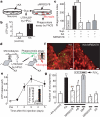UDP acting at P2Y6 receptors is a mediator of microglial phagocytosis
- PMID: 17410128
- PMCID: PMC3464483
- DOI: 10.1038/nature05704
UDP acting at P2Y6 receptors is a mediator of microglial phagocytosis
Abstract
Microglia, brain immune cells, engage in the clearance of dead cells or dangerous debris, which is crucial to the maintenance of brain functions. When a neighbouring cell is injured, microglia move rapidly towards it or extend a process to engulf the injured cell. Because cells release or leak ATP when they are stimulated or injured, extracellular nucleotides are thought to be involved in these events. In fact, ATP triggers a dynamic change in the motility of microglia in vitro and in vivo, a previously unrecognized mechanism underlying microglial chemotaxis; in contrast, microglial phagocytosis has received only limited attention. Here we show that microglia express the metabotropic P2Y6 receptor whose activation by endogenous agonist UDP triggers microglial phagocytosis. UDP facilitated the uptake of microspheres in a P2Y6-receptor-dependent manner, which was mimicked by the leakage of endogenous UDP when hippocampal neurons were damaged by kainic acid in vivo and in vitro. In addition, systemic administration of kainic acid in rats resulted in neuronal cell death in the hippocampal CA1 and CA3 regions, where increases in messenger RNA encoding P2Y6 receptors that colocalized with activated microglia were observed. Thus, the P2Y6 receptor is upregulated when neurons are damaged, and could function as a sensor for phagocytosis by sensing diffusible UDP signals, which is a previously unknown pathophysiological function of P2 receptors in microglia.
Figures




Comment in
-
Neuroscience: the brain's garbage men.Nature. 2007 Apr 26;446(7139):987-9. doi: 10.1038/nature05713. Nature. 2007. PMID: 17410127 No abstract available.
References
Publication types
MeSH terms
Substances
Grants and funding
LinkOut - more resources
Full Text Sources
Other Literature Sources
Molecular Biology Databases
Miscellaneous

